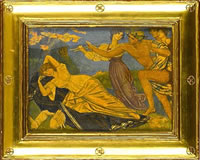Southall was
born in Nottingham of Quaker parents, and was taken by his mother to Birmingham
when his father died the following year. In
i874 he entered the Friends' School.
Bootham, where he was taught painting
by Edwin Moore (brother of Albert and Henry). Four years later he joined
the Birmingham
firm of architects, Martin and Chamberlain, but in 1882 he left to concentrate
on painting, attending the Birmingham School of Art where he met A J
Gaskin, henceforth his closest friend, and
other members of the Birmingham
Group. About the same time he settied
at 13 Charlotte Road, Edgbaston, his home for the rest of his life. In 1883 he
spent eight weeks in Italy, absorbing the early masters, and on his return he began to experiment with tempera. Meanwhile, through an uncle, he had made the acquaintance of Ruskin, who commissioned him to design a museum for
the Guild of St George at Bewdlev (1885);
this came to nothing but took him
again to Italy.
He also received encouragement from W
B Richmond and Burne Jones, to whom he
paid visits in London
(1893-7). In 1895 he began to exhibit at the RA (Car. 72),
showing there till 1942, while also supporting the New Gallery (1897-19o9), the RBSA (Associate 1898. member 1902)
and the Arts and Crafts Exhibition Society shows (1899-1923). In 1901, together with J D Batten, Walter Crane and others,
he helped to found the Society of
Painters in Tempera, and he was
undoubtedly the single most important
exponent of the tempera revival. Though never, like so many members of the Birmingham Group, on the staff of the local Art School,
he gave lessons on tempera painting
in his Edgbaston studio and lectured on the subject widely. As well as literary
figure subjects, he painted genre scenes, portraits and landscapes; his wife Anna Elizabeth, a first cousin whom he married in 19o3, appears in many of his pictures,
and often helped to decorate their elaborate gilded
frames. Southall was a leading figure among Birmingham Quakers, a Socialist and pacifist; he campaigned vigorously
against the conduct of the Great War,
during which he painted the fresco of 'Corporation Street, Birmingham, in March 1914', on
the staircase of the Birmingham
Art Gallery, (completed in 1916).
In later life he joined the NEAC and RWS (1925), participated
in joint exhibitions with other
Birmingham and tempera painters, held a number of one-man shows (notably at the Alpine Club 1922), and,
building on the success of an
exhibition at the Galeries
Georges Petit in Paris in 1910, established a
considerable international reputation. He and his wife paid frequent visits to Italy,
sometimes with Charles and Margaret Gere; also to France, Southwold and Fowey, where
he found many subjects.
In 1933 he was appointed Professor of
Painting at the RBSA (President 1939),
and in 1937 began a fresco in the Council House. It was not, however, completed; that August he underwent a major operation
and never fully recovered, dying in 1944. A
memorial exhibition was held at Birmingham, the RWS
and Bournemouth the following year.


 sold
sold  reserved
reserved  private collection
private collection